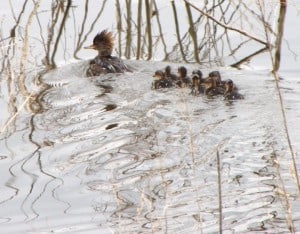On August 11, the same day I saw the Western Kingbird, I was treated to the sight of a young wren, still with the yellow on the edges of its beak, calling persistently for some parental attention I presume. Also there was a Spotted Sandpiper on what I call our stone bridge in the river. We see this bird now and then. This one was doing its usual bobbing up and down as it searched the rocks, but there were no spots on its breast this time, only the characteristic white wedge on the side of the breast. I presume it was now in what is described in my books as its winter plumage. The next day there was a Black-and-white Warbler in a white pine just outside our dining room window, but it was soon chased off by a chickadee. Our Hooded Merganser managed to raise five young this year, and we’ve see six Common Mergansers on the river, all in the “female” plumage,
This year we’ve been aware of a distinct drop in the number of frogs we’ve seen. We have our usual Grey Tree Frog living just under our deck and for a while it was joined by two friends, both quite small, but I’ve only seen a few Green Frogs and one Wood Frog this year. The Northern Leopard Frogs, usually fairly numerous, seem to have almost disappeared. But one interesting sighting has again confused me. On the 18th I saw what I assumed was a small toad, maybe about two inches long in a crouched position, under our deck. However, when I checked my books, the only toad that fit the description was a Common Toad, which I gather is not normally found here. The toad had a more frog-like head, unlike the American Toad, it was a mid-brown in colour with lots of warty bumps, but it also had the characteristic light stripe down the centre of its back. I shall take its picture if I am fortunate to see it again.
It was interesting to read comments on your website about the proliferation of biting insects this year. I am still wearing a bug shirt when I garden. The mosquitoes just love me, and so do what I thought might be the No-see-ums. These latter are smaller and lighter in colour, and they sure do bite!
About the Hummingbird Clearwings – we regularly see this charming insect. When we were living in the north of England, I once saw its larger European cousin, the Hummingbird Hawkmoth, looking quite bedraggled, probably not well equipped for the colder, wetter climate. We first saw them enjoying a much warmer climate while on holiday in France, together with large black bumblebees, a quite surprising sight.
Stephenie Armstrong, Sawmill Road near Warsaw
